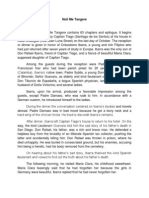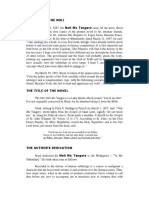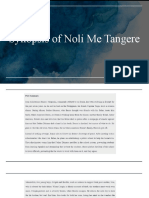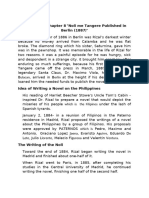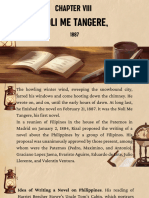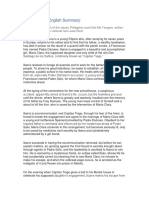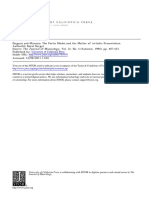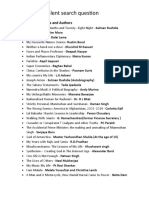Midterm
Midterm
Uploaded by
Reya MeiCopyright:
Available Formats
Midterm
Midterm
Uploaded by
Reya MeiCopyright
Available Formats
Share this document
Did you find this document useful?
Is this content inappropriate?
Copyright:
Available Formats
Midterm
Midterm
Uploaded by
Reya MeiCopyright:
Available Formats
CHAPTER 8 February 21,1887- the first novel Noli Me Tangere was finished IDEA OF WRITING ON PHILIPPINES: The reading
g of Harriet Beecher Stowes Uncle Toms Cabin- which portrays the brutalities of American slaveowners and the pathetic conditions of the unfortunate Negro, Slaves, inspired Dr. Jose Rizal to prepare a novel on the Philippines Rizal was a student in the Central University of Madrid Rizal proposed is writing of a novel about the Philippines during the reunion of Filipinos in the house of the Paternos in Madrid on January 2,1884 His proposal was unanimously approved by: 1. Pedro 2. Maximo 3. Antonio They were Paternos 1. Graciano Lopez Jaena 2. Evaristo Aguirre 3. Julio Llorente 4. Valentin Ventura 5. Eduardo De Lete The end of 1884-Rizal began writing the novel in madrid and he finished one half of it 1885 He went to Paris for completing his studies in the Universidad Central De Madrid He continued writing the novel, finishing the one half of the second half. GERMANY 1886 During the dark days While his spirit was at its lowest ebb, he almost threw the manuscript into the fire The novel was almost finished He was desperately desponded because he saw no hope of having it to published for he was utterly penniless FERNANDO CANON- friend of Rizal MID DECEMBERa telegram from Barcelona arrived THE TELEGRAM Sent by Dr. Maximo Viola, informing Rizal of his coming visit to Berlin The message revived the authors Hope Dr. Maximo Viola A scion of a rich family of San Miguel Bulacan Would surely lend him the money for the publication of the novel The man had saved Noli
Viola was a Godsend Viola came to Berlin to invite Rizal to join him in a tour of Europe When he learned of Rizals predicament, he kindly agreed to postponed the tour and instead, advanced some money so that the novel could be printed
1887 First edition of Noli Me Tangere was printed in Berlin P300.oo cost of printing (advance by Viola) for 2000 copies MARCH 29,1887 Rizal gave the Galley Proofs of the Noli A significant date for it was the date when the Noli Me Tangere came off the press NOLI ME TANGERE - a latin phrase which means Touch me not, from the bible MARCH 1887 Rizal writing to Felix R. Hidalgo in french Noli Me Tangere words taken from the gospel of St.Luke Rizal made a mistake. It should be the gospel of St. John, on the first Easter Sunday St. John(chapter 20:13-17) ST.MARY MAGDALENE - visited the Holy Sepulchre, and to her our Lord Jesus, just arisen from the dead The authors dedication. Rizal dedicated the Noli Me Tangere to the Philippines to my country his dedication runs as follows: Recorded in the history of human sufferings is a cancer so malignant a character that the least touch irritates it and awakens in it the sharpest pains. Thus, how many times, when in the midst of modern civilization i have wished to call thee before me, now to accompany me in memories Now to compare thee with other countries, hath thy dear image presented itself showing a social cancer like a to that other! Desiring thy welfare which our own, an seeking the best treatments, i will do with thee what the ancient did with their seek exposing them on the steps of the temple so that everyone who came to invoke the divinity might ofer them a remedy. And to this end, I will strive to reproduce thy condition faithfully, without discrimination, I will raise a part of the veil that covers the evil, sacrificing to truth everything, even vanity itself. Since, as thy son i am conscious that I also suffer from thy defects and weaknesses. NOLI ME TANGERE Contains 63 chapters and an epilogue It begins the reception given by Captain Tiago (Santiago De Los Santos) at his house in Calle Anloague ( Now Juan Luna Street) on the last day of October
CRISOSTOMO IBARRA A young and rich Filipino who had just turn after 7 years of study in Europe The reception or dinner was given in honor of Crisostomo Was only son of Don Rafael Ibarra DON RAFAEL IBARRA Friend of CapitanTiago and fiance of beautiful Maria Clara supposed daugther of Capitan Tiago GUEST DURING RECEPTION 1. Padre Damaso - a Franciscan Friar who had been priest of San Diego( Calamba), Ibarras native town for 20 years 2. Padre Sibyla - a young dominican parish priest of Binondo 3. Senor Guevara - an elderly and kind lieutenant of the GuardiaCivil DON TIBURCIO de ESPADANA - a bogus Spanish Physician , lame, and henpeckead husband of Dona Victorina and several ladies. PADRE DAMASO - was in a bad mood because he got a bony neck and hard wing of the chicken Tinola. - he tried to discredit Ibarras remarks. =AFTER DINNER= Ibarra Left captain Tiagos house to return to his hotel. On the way, the kind lieutenant Guevarra told him the sad story of his fathers death in San Diego. Don Rafael his father, was a rich and brave man. He defended a helpless boy from the brutality of a illiterate Spanish tax collector, pushing the latter and accidentally killing him. He was thrown in prison, where he died unhappily. He was buried in consecrated ground but his enemies, accusing him of being a heretic, had his body removed from the cemetery. On hearing his fathers sad story, Ibarra thanked the kind Spanish lieutenant and vowed to find out the truth about his fathers death. =THE FOLLOWING MORNING= Ibarra, visited Maria Clara, his childhood sweetheart Maria Clara teasingly said that he had forgotten her because the girls in Germany were beautiful, then Ibarra replied that he had never forgotten her. After the romantic reunion with Maria Clara, Ibarra went to San Diego to visit his fathers grave. It was All Saints Day..at the cemetery, the grave digger told Ibarra that the corpse of Don Rafael was removed by order of the parish priest to be buried in the Chinese cemetery. But the corpse was heavy and it was a dark rainy night so that he simply threw the corpse into the lake. Ibarra was angered by the grave-diggers story. He left the cemetery.
On the way, he met Padre Salvi Franciscan parish priest of San Diego. In a flash, Ibarra pounced on the priest , demanding redness for desecrating his fathers mortal remains. PADRE SALVI- told him that he had nothing to do with it, for he was not the parish priest at the time of Don Rafaels death. It was Padre Damaso, his predecessor, who was responsible for it. Convinced of Padre Salvis innosence, Ibarra went away. In his town, Ibarra met several interesting people, such as the wise old man Tasio the Sage, whose ideas were too advanced for his times so that the people, who could not understand him, called him Tasio the Lunatic. The progressive school teacher, who complied to Ibarra that the children were losing interest in thier studies because of lack f a proper schoolhouse and discouraging attitude of the parish priest toward teaching of Spanish and the use of modern method of PEDAGOGY. The spineless gobernadorcillo, who catered to wishes of the Spanish priest: 1. Don Filipo Lino - the teniente mayor and leader of the liberal function in the town. 2. Don Melchor - the captain of the cuadrilleros(town police). Former Gobernadorcillo who were prominent citizens: 1. Don Basilio 2. Don Valentin Most tragic story in the novel is the tale of Sisa, who was formerly a rich girl but became poor because when she married a gambler. SISA- became crazy because she lost her two boys. BASILIIO AND CRISPIN - only joys of her wretched life. These boys were sacristans(sextons) in the church, working for a small wage to support their poor mother. CRISPIN - the younger of the two brothers, was accused by the brutal sacristan mayor(chief tortured) in the convent and died. BASILIO - with his brothers dying cries ringing in his ears, escaped. when the two boys did not return home, Sisa looked for them everywhere and in her great sorrow, she became mad. Capitan Tiagos cousin who took care of Maria Clara, after her mothers death arrived in San Diego. Ibarra and his friends gave picnic, were Maria Clara and her four girl friends. The Merry Sinang The Grave Victoria The Beautiful Iday The Thoughtful Neneng AUNT ISABEL - chaperon of Maria Clara
CAPITANA TIKA - mother of Sinang ADENG - foster-sister of Maria Clara ALBINO - the ex-theological student who was in love with Sinang and Ibarra and his Friends. ELIAS - one of boatmen was a strong silent, pleasant youth. An accident of the picnic was the saving of Elias life by Ibarra. ELIAS - bravely grappled with the crocodile which was caught in the fish corral, but crocodile struggled furiously so that Elias could not subdue it. Ibarra jumped into the water and killed the crocodile, thereby saving Elias. Another accident, which preceded the above-mentioned neat-tragic culture incident, was the rendering of a beautiful song by Maria Clara who had a sweet voice. Upon the insistent request of her friends, she played the sharp and sang. The Song of Maria Clara Sweet are the hours in ones native land, Where all is dear the sunbeams bless; Life-giving breezes sweep he strand. And death is softened by Loves cares Warm kisses play on mother Lips, On her fond, tender breast awakening; When round her neck the soft arm slips. And bright eyes smile, all love partaking Sweet is death for ones native land, Where all is dear the sunbeans bless: AFTER MARIA CLARAS SONG AND THE CROCODILE INCIDENT, THEY WENT A SHORE THEY MADE MERRY IN THE COOL,WOODED MEADOWS. Padre Salvi Capitan Basilio (former gobernadorcillo and Sinangs father) Alferez(lieutenant of guardia civil) Town officials were present THE MEAL OVER Ibarra and Capitan Basilio played chess. Maria Clara and friends played the Wheel of Chance(game based on a fortune telling book). AFTER A SEARGENT AND FOUR SOLDIERS OF THE GUARDIA CIVIL SUDDENLY ARRIVED, LOOKING FOR ELIAS, WHO HAS HUNTED FOR 1. Assaulting Padre Damaso 2. Throwing the Alferez into the mud hole. Fortunately, Elias has disappeared and the Guardia civil went away empty handed. During the picnic also, Ibarra received a telegram from the Spanish authorities notifying
him of the approval of his donation of a schoolhouse for the children of San Diego. The next day Ibarra visited old Tasio to consult him on his pet project about the schoolhouse. He sar the old mans writings were written in heiroglyphics. Tasio explained to him that he wrote hieroglyphics because he was writing for the future generations who would understand them and say: NOT ALL WERE ASLEEP IN THE NIGHT OF OUR ANCESTORS. NOR JUAN - an architect continued the construction of school house. San Diego was preparing for its annual fiesta, in Honor of its patron saint San Diego de Alcala whos feast day is the 11the of November. On the eve of the fiesta, hundreds of visitors arrived from nearby towns, and there were laughter, music, exploding bombs, feasting and moro-moro. The music was furnished by: 1. 5 brass bands(including the famous Pagsanjan Band owned by escribano Miguel Guevarra.) 2. 3 orchestras In the morning of the fiesta there was a high mass in the church; officiated by Padre Salvi. Padre Damaso gave the long sermon, in which he expatiated on the evils of the times that were caused by certain men who having tested same education. After Padre Damasos sermon, the mass was continued by Padre Salvi. Elias quietly moved Ibarra, who was kneeling and praying my Maria Claras side, and warned him to be careful during the ceremony of the lying of the cornerstone of the school house because there is a plot to kill him. Elias- suspected that the yellowish man built the derrick, was a paid stooge Ibarras enemies. True to his suspicion , later in the day when Ibarra in the presence of a big crowd, went down into trench to cement the cornerstone, the derrick collapse. Elias quick as a flash pushed him aside, saving his life. the yellowish man was the one crushed to death by the shattered derrick. At the dinner that night. The arrogant Padre Damaso, speaking in the presence of many guest, insulted the memory of Ibarras father. Ibarra jumped from his seat, knocked down the fat friar with his first and then seized with sharp knife. He would killed the friar, were it not far the timely intervention of Maria Clara. Ibarras attack on Padre Damaso produced 2 results: 1. His engagement to Maria Clara was broken. 2. He was excommunicated. =THE FIESTA OVER=
MARIA CLARA - became ill - treated by the quack physician Tiborcio de Espadana. DOCTORA DONA VICTORINA de LAS REYES De ESPADANA Wife of Tiburcio de Espadana A vain, frustrated native woman A frequent visitor on Capitan Tiagos house Had halucinations of being superior Castilica. She looked down on her own people as inferior being. She added another de to her husband to become more spanish. DON ALFONSO LINARES DE ESPADANA cousin of Don Tiburcio de Espadana Godson of Padre Damasos brother in law. A touch of comedy in the novel was the fight bet. 1. Dona Consolacion - the vulgar mistress of the Spanish alferez 2. Dona Victorina - flam-boyantly dresses wife of a henpecked Spanish quack doctor. STORY OF ELIAS Tale of pathos and tragedy He related it to Ibarra Some 60 years ago his grandfather His grandfather who was a young bookkeeper in a Spanish commercial firm in Manila. Was wrongly accused of burning the firms warehouse. Was a plogged in public and was left in the street, crippled and almost dead. His wife Who was pregnant Begged for alms Become a prostitute in order to support his sick husband and son. After giving birth to her second and the death of her husband, she fled with her two sons to the mountain. =YEARS LATER= FIRST BOY Became a dreaded tulisan named Balat. He terrorized the provinces. His head was cut off and was hung from the tree branch in the forest. YOUNG BROTHER Who was by nature kind-hearted. Fled and became a trusted laborer in the house of a rich man in Tayabas. He fell in love with the Master daughter. Unfortunate lover(Elias Father)
Was sent to jail while the girl gave birth to twins a boy(Elias) and a girl. Elias Educated in the Jesuit College in Manila His sister studied in La Concordia College They lived happily until one day, over money matters; distant relatives exposed their shame full birth. They were disgraced. An old male servant whom they used to abuse, was forced to testify in court and the truth came out that he was their real father. Elias and his sister left Tayabas to hide their shame in another place. One day his sister disappeared. Elias roamed from place to place looking for her. He heard later that a girl answering to his sisters description, was found on the beach of San Diego. Elias, learning of Ibarras arrest, burned all papers that might incriminate his friends and set Ibarras house on fire. Then he went to prison and helped Ibarra escape. He and Ibarra jumped into a BANCA loaded with ZACATE (grass). Ibarra stopped to Capitan Tiago to say goodbye to Maria Clara. After bidding Maria Clara farewell, Ibarra returned to the Banca . He and Elias paddled up the Pasig river toward Laguna de Bay. A police boat with the Guardia civil on board. Elias told Ibarra to hide under zacate. Elias jumped into the water and swam swiftly toward the shore. He diverted the attention of the soldiers on his person giving Ibarra a chance to escape. Elias seriously wounded, reached he shore and went into the forest. He met a boy Basilio, weeping over his mothers body. He told Basilio to make a pyre on which their bodies were to burned to ashes. It was Christmas eve and the moon gleamed softly in the sky. Basilio prepared the funeral pyre. Elias looked toward the east and murmured I die with out seeing the dawn brighten over my native land. You who have it to see, welcome it and forget not those who have fallen during the night. The novel was an epilogue which recounts what happened to the other characters. Maria Clara -entered the Santa Clara nunnery Padre Salvi - left parish San Diego and became a chaplain of the nunnery. Padre Damaso - transferred to remote province but he was found dead in his bedroom. Capitan Tiago - became an opium addict and a human wreck.
Dona Victorina - still henpecking poor Don Tiburcio. - wearing eye glass because weakening eyesight. Linares - died of dysentery. -buried in Paco cemetery. Alferez - was promoted Major. -he returned to Spain -leaving his shabby mistress Dona Consolacion =THE NOVEL ENDS WITH MARIA CLARA, UNHAPPY IN STA CLARA NUNNERY. FOREVER LOST IN THE WORLD.= (Noli based on truth) Noli ME TANGERE True story of Philippine conditions during the last decades of Spanish rule. Places, character and situation really exist. =THE CHARACTERS= MARIA CLARA- was Leonor Rivera IBARRA and ELIAS- represented Rizal himself TASIO the SAGE- was his elder brother (Paciano). PADRE SALVI- identified by Rizalist as Padre Antonio Piernavieja. CAPITAN TIAGO- was Capitan Hilario Sunico of San Nicholas. DONA VICTORINA- was Dona Agustina Medel BASILIO and CRISPIN- were Crisostomo brother of Hogonoy. PADRE DAMASO- was typical of a domineering friar during the days of Rizal, who was arrogant, supercilious and AntiFilipino. RIZAL FRIENDS PRAISE THE NOLI Friends of Rizal hailed the novel, praising it in glowing colors. Rizal anticipated the vitriolic attacks of his enemies, who were sore to be told the truth of the evil ways. In Rizal own words. The government and the friars will probably attacking on the work, refusing the statement, but the trust in the God of Truth and in the persons who have actually seen our sufferings. =COPIES OF NOLI WERE SENT BY RIZAL TO...= Blumentritt Regidor Hidalgo Mariano Ponce Graciano Lopez Jaena Aguirre =MORE COPIES WERE CRATED AND SENT TO...= BARCELONA MADRID
HONGKONG CHAPTER 9 ELIAS and SOLOME the Missing Chapter of NOLI Few people know that there is a missing chapter in the printed Noli Me Tangere, this chapter was included in the original manuscript, written in Rizals own handwriting However, it was crossed out in blue pencil so that it was deleted from the printed novel. WHY RIZAL DELETES THE CHAPTER? It should be recalled that Rizal was in dire financial situation in Berlin during the days when he was putting the finishing touches to the Noli. He knew that the cost of printing is in proportion with the number of pages of the manuscript. Accordingly, he rewrote several chapters making them more compact so that he could economize on the number of pages. He deleted one whole chapter without destroying the story of the novel and this chapter was Elias and Salome ECONOMIC was the only reason why this particular chapter was deleted. Elias was adversely affected. It seems that Rizal considered Ibarra a more important character although Elias was nobler. He even killed Elias in the novel and let Ibarra live. Later, he repented having killed Elias. He wrote im sorry i have killed Elias instead of Crisostomo Ibarra . But when Rizal wrote the Noli his health was very bad and he never believe that he could wrote the continuation and talk about revolution. He have preserve the life of Elias a nobler character, a patriot, unselfish and self-sacrificing, the necessary qualities for a man to lead a revolution. Crisostomo Ibarra was an egoist who decided to provoke a rebellion only when he was injured through his property, his person, his love and all that he held sacred. Success cannot be expected for the enterprise of a man like that. SYNOPSIS OF THE MISSING CHAPTER In a nipa hut by the placid lake, Salome a winsome girl in her early teens sat on the bamboo batalan sewing a camesa of bright colors. She was waiting for Elias to arrived. She was beautiful like the flowerets that grow wild not attracting attention at first glance but whose beauty is revealed when we examined them carefully. When she heard footsteps, she laid aside her sewing, went to the bamboo stair way. Salome noticed her lover was sad and Pensive. She tried to console him; asking about the girls @ the picnic which the Guardia Civil soldiers disturbed looking for him. Elias told her that there were many beautiful girls among whom was Maria Clara, the sweetheart of a rich young man who just came from Europe. Afterwards, the young man rose preparing to leave, speaking in a soft voice, he said Good-bye, Salome, The sun is setting and it wont appear good for the people to know that night over took me here. Salome was crying, for soon she would leave this house where she grew up. She explained : It is not right for me to live alone. Ill go to live with my relatives in Mindoro. Soon Ill be able to pay the debt my mother left me when she died...to give up this house in which one was born and has grown up is something more than giving up ones being. A typhoon will come , a freshet and everything will go to the lake. Elias remained silent for a moment, then he held her hands, and asked her: Have you heard anyone speak ill of you? Have I sometimes worried you? Not that either? Then you are tired with my friendship & want to drive me away. Salome answered: No, dont talk like that. I am not tired of your friendship. God knows that I am satisfied with my lot. I only desire health that I may work. I dont envy the rich, the wealthy, but... But what? Nothing. I dont envy them as long as I have your friendship .....Then they have conversation. Then Elias said to Salome Forget me, Forget a love so mad & futile. Perhaps youll meet there one who is not like me Elias , exclaimed the girl reproachfully. You have misunderstood me; I speak to you as I would speak to my sister if she were alive; in my words there is not a single complaint against you. Take my advice, go home to your relatives. Here you have no one but me, & the day when I fall into the hands with my pursuers, you will be left alone for the rest of you life. improve your youth & beauty to get a good husband, such as you deserve for you dont know what it is to live among men Salome was thinking that Elias go with her. Elias then narrated what happened earlier at the picnic that morning; how he was saved by Ibarra from the jaws of a crocodile. To show his gratitude, he vowed to repay the good deed done by Ibarra to the extend with sacrificing his life. He explained that anywhere he would go, even to Mindoro, the past would still be discovered, sooner or later. Well then, Salome said, looking @ him tenderly: at least when Im gone, live here, stay in the house. It will make you remember me; and I will not think in that
distant land that the hurricane had carried my hunt to the lake. When my thoughts turns to these shores. The memory of you and of my house will appear to me together. Sleep where I have slept & dream it will be as though I were beside you. Oh exclaimed Elias, waving his hand in desperation, Woman, youll make me forget. After disengaging himself from her tender embrace, he left with a heavy heart, following the shadows of somber tree in the twilight. She followed her with her gazed, listening sadly to the fading footsteps in the gathering darkness. CHAPTER 10 RIZALS TOUR OF EUROPE WITH VIOLA After the Noli was printed in Berlin, Rizal planned to visit the important places in Europe. Rizal received Pacianos remittance of P1,000. He paid Dr. Maximo Viola P200 for Rizal loaned so that the Noli could be printed. Having paid his debt, and with enough funds in his pocket, Rizal accompanied by Viola, was ready to see Europe before returning home to Calamba. (Words in red are the places they visited.) They visited first Potsdam, a city near Berlin, which Frederick the Great made famous. Dresden, one of the best cities in Germany. Teschen (now Decin, Czechoslovakia) Leitmeritz (Litomerice), Bohemia Here at Leitmeritz, Rizal met Blumentritt for the first time. Blumentritt is an old Austrian professor. Rosa, his wife, Dolores, Conrad and Fritz, Blumentritts children. Prague, here they visited: * the tomb of Copenicus (the famous astronomer) * the museum of natural history * the bacteriological laboratories * the famous cave where San Juan Nepomuceno, (the Catholic saint) was imprisoned * and the bridge where the saint was hurled into the river Brunn, according to Viola, nothing happened in this city. Vienna (capital of Austria-Hungary), known as the Queen of Danube, famous in songs and stories Danubian Voyage (Danube river cruise) Lintz Salzburg Munich, they stopped here for a short time for the famous Munich beer, best in Germany Nuremberg, one of the oldest cities in Germany Ulm, the cathedral of this city was the largest and tallest in Gemany
Stuttgart Baden Rheinfall, they saw the waterfall, the most beautiful waterfall in Europe Scaffhausen, Switzerland Bassel Bern Lausanne Lemon Lake Geneva, the Swiss city, one of the most beautiful cities in Europe languages spoken by the people of Geneva: * French * German * Italian June 13 -- Viola returned to Barcelona -- Rizal continued the tour to Italy Turin Milan Venice Florence Rome, the City of Caesars Vatican, the City of the Popes, the capital of Christendom *Rizal wrote to Blumentritt, I am tired as a dog, but I will sleep as a god. *After a week of wonderful tour in Rome, he prepared to return to the Philippines CHAPTER 11 Back To Calamba, 1887-88 Rizal-was a true Filipino. All the alluring beauties of foreign countries and all the beautiful memories of his sojourn in alien lands could not make him forget of home nor turn his back to his own nationality. True that he studied abroad, acquired the lore and languages of foreign nations, and enjoyed the friendship of many great men of the Western world; but he remained at heart a true Filipino with an unquenchable love for the Philippines and an unshakeable determination to die in the land of his birth. Thus, after five years of memorable sojourn in Europe, he returned to the Philippines in August, 1887. he practised medicine in Calamba. He operated successfully on his mothers eyes and lived the quiet life of a country doctor. Unfortunately his enemies, who resented Noli, persecuted him, even menacing his life. Decision to Return Home ...after the publication of the Noli Me Tangere Rizal was warned not to return home by: *Paciano (his brother) *Sivestre Ubaldo (his brother-in-law) *Chengoy (Jose M. Cecilio) *Other Friends Reasons why he was determine to return to the Philippines: to operate on his mothers eyes to serve his people who had long been oppressed by Spanish tyrants
to find out for himself how the Noli and his other writings were affecting Filipinos and Spaniards in the Philippines; and to find out why Leonor Rivera had remained silent. Delightful Trip and Arrival to Manila Rizal left Rome by train for Marseilles, a French port On July 3, 1887- he boarded the steamer Djemnah. On August 6th he arrived in Manila. *There were about fifty passengers, including 4 English, 2 Germans, 3 Chinese, 2 Japanese, and many Frenchmen. *He found Manila the same as when he left it five years ago. Happy Homecoming On August 8th, the two days after his arrival in Manila, he reached Calamba. His family welcomed him affectionately, with plentiful tears of joy. Paciano did not leave him during the first days after arrival to protect him from enemy assault. Rizal, who came to be called Doctor Uliman because he came from Germany. He was able to earn $900 as a physician Rizal opened a gymnasium for young folks. Storm over the Noli Rizal received a letter from Governor General Emilio Terero to come to Malacaang Rizal visited Fr. Francisco Sanchez, Fr. Jose Bech, and Fr. Federico Faura. Father Faura ventured an opinion that everything in it was the truth, but added: You may lose your head for it. Don Jose Taviel de Andrade, as bodyguard of Rizal belonged to a noble family The Archbishop of Manila, Msgr. Pedro Payo (a Dominican), sent a copy of the Noli to Father Rector Gregorio Echavarria of the University of Santo Tomas for examination by a committee of the faculty. *(there were no mass imprisonment or mass execution of Filipinos. He refused to be intimidated by the friars who clamored for positive repressive measures against people caught reading the novel and vindictive action against its author.) because of Gov.Gen.Terero DEFENDERS OF NOLI Marcelo H. Del Pilar- editor of La Solidaridad -he published a pamphlet entitled Caiigat Cayo Caiigat Cayo- it means Be slippery as an Eel
Father Francisco Sanchez- Rizals beloved Jesuit professor Don Segismundo Moret- a former President of the Council of Minister -he read and like the book very much. Rev. Vicente Garcia- a Filipino Catholic priest-scholar, a theologian of the Manila Cathedral and a Tagalog translator of the famous Imitation of Christ by Thomas A Kempis Father Garcia- writing under the pen name Justo Desiderio Magalang -he wrote a defense of the Noli which was published in Singapore as an appendix to a pamphlet dated on July 18, 1888. RIZAL AND ANDRADE Lt. Jose Taviel de Andrade- a Spanish bodyguard, -he was assigned as a bodyguard of Rizal by GovernorGeneral Terrero - between Lt. Andrade and Rizal, a beautiful friendship bloomed. Calambas Agrarian Trouble - Governor-General Terrero, influenced by a certain facts in Noli Me Tangere, ordered a government investigation of the friars estates to remedy whatever iniquities might have been presents in connection with land taxes and with tenant relations. A POEM FOR LIPA Before Rizal left Calamba in 1888 his friend from Lipa requested him to write a poem in commemoration of the towns elevation to a villa (city), by virtue of the Becerra Law of 1888. He wrote a poem this was the Himno Al Trabajo (Hymn to Labor). He finished it and sent to Lipa before his departure from Calamba. CHAPTER 12 HONGKONG, MACAU & JAPAN 1888 Rizal leaving the Philippines for the Second Time Hong Kong A British colony Rizal stayed in Victoria Hotel He met Jose Maria Basa Balbino Mauricio Manuel Yriarte (son of the alcalde mayor in Calamba) According to Rizal in his letter to Blumentritt, is a small, but very clean city. Many Portuguese, Hindus, English, Chinese and Jews. There are some Filipinos exiled in Marianas Islands since 1872, they were former financiers and rich but now poor, gentle and timid. Rizals Visit to Macau A Portuguese colony near Hong Kong. Rizal together with Basa boarded a ferry named Kiu-Kiang going to Macau. Jose Sainz de Varanda among one of the passengers
Don Juan Francisco Lecaros a Filipino gentleman who is married to a Portuguese lady. Rizal and Basa stayed in his house for two days while they were in Macau. During Rizals two week vacation in Hong Kong, he studied Chinese life, language, drama and customs and found out the following which he wrote in his diary: The celebration of the Chinese New Year was quite very noisy due to the continuous explosion of firecrackers on the streets. The lauriat party, wherein the guests were served a variety of dishes, shows lavishness and hospitality among the Chinese. The Dominican Order, the richest religious order in Hong Kong, had millions of dollars deposited in various banks earning very high interests. The graveyards for Catholics, Protestants and Muslims were well maintained. CHAPTER 13 RIZAL IN JAPAN The Land of the Cherry Blossoms Rizal left Hong Kong on board of the Oceanic, an American steamer on his way to Japan. He arrived in Yokohama, Japan and stayed for one day in Grand Hotel. Rizal in Tokyo After spending a day in Yokohama, Rizal went to Tokyo and stayed in Tokyo Hotel for five days. Tokyo Hotel- where Rizal stayed from March 2-7 in Japan Rizals letter to Blumentritt. Tokyo is more extensive than Paris. The walls are built in cyclopean manner. The streets are large and wide JUDO Japanese art of self defense KABUKI Japanese drama play He could economize his living expenses He had nothing to hide from the prying eyes of the Spanish authorities. He and Caballero became good friends. In Japan, Rizal was embarrassed because he did not knew how to speak Niponggo (Japanese Language) He was mistaken as an Europeanized Japanese because he looks like a Japanese and yet speaks in different tongue. Rizals Impression of Japan The scenic beauty of the country The cleanliness, politeness and industry of the Japanese people.
The picturesque dress and simple charm of the Japanese women. There were few thieves in Japan. Beggars are rarely seen in the city streets. Rickshaw Rickshaw a popular mode of transportation which he did not like in Japan. Rizal and O-Sei-San A samurais daughter of 23 years old and had never experienced true love. Usui San, her father; a store owner A woman of beauty, charm, modesty and intelligence. Speaks French and English When Rizal first introduced himself to her, he took of his hat as a sign of respect ( A German custom) O-Sei-San was more than Rizals girlfriend for she was his guide, interpreter and tutor. She improved his knowledge of the Japanese language. She eases the pain left by Leonor Rivera. Rizal and Osei San are both theatre addicts. They attended some kabuki plays such as; Sendaihagi Manjiro Nakahama Chushingura Rizal fell greatly in-love with O-Sei-San that he was tempted to leave the Philippines and settle down in Japan. He was offered a job in the Spanish Legation Paciano wrote to him reminding him of his duty and why he left the Philippines in the first place. Rizal left Japan via the ship Belgic, an English steamer in Yokohama bound for United States. It ended 45 days of his unforgettable stay in Japan and his relationship with O-Sei-San. O-Sei-San after Rizals departure Alfred Charlton became the husband of O-Sei-San in 1897, one year after Rizal was executed. He was a British teacher of chemistry in Peers School in Tokyo. They had a daughter named Yuriko, who married a son of a Japanese senator Seiko-Usui died in 1947 at age 80 and was buried beside her husband. Sayonara japan April 13, 1888 Rizal left Japan boarded in Belgic, an English steamer bound for United States Tetcho Suehiro a fighting Japanese journalist, novelist, champion of human rights, who was forced by the government to leave Japan.
He met a semi-Filipino family Mr. Reinaldo Turner and his wife Emma Jackson, their children and maid from Pangasinan. Tetcho Suehiro Became a member of the Japanese Imperial Diet (Parliament) Wrote to novels: Nankai-no-Daiharan (Storm Over the South Sea) 1891 resembling Noli Me Tangere O-unabara (The Big Ocean) 1894 resembling El Filibusterismo Died in 1896 at age 49 due to heart attack. Advocates of Freedom Rizal Tetcho Suehiro
CHAPTER 13 RIZAL IN AMERICA April 28, 1888 Rizal first saw America. Steamer Belgic which he rides going to San Francisco. 643 Number of Chinese coolies that the ship was carrying. May 4, 1888 the day he was permitted to go ashore. Place Hotel a 1st class hotel where Rizal stayed. Leland Stanford who was a millionare senator representing California in U.S. senate at that time. Grover Cleveland - The president of the United States May 6, 1888 Rizal left San Francisco for Oakland. May 7- May 13 was grand transcontenintal trip. Reno, Nevada the biggest little city in the world. Omaha a big city, the biggest since Rizal left San Francisco. Missouri River twice as wide as the Pasig River. Places where Rizal went: Reno Nevada Ogden Nebraska Chicago Albany May 13 Rizal reach New York. New York - which Rizal called the big town. May 16, 1888 he left New York for Liverpool on board the City of Rome. Rizal had good and bad impression in America: *THE GOOD IMPRESSIONS WERE* The material progress of the country as shown in the great cities, huge farms, flourishing industries,and busy factories The drive and energy of the American people The natural beauty of the land
The high standard of living and; The opportunities for better life offered to poor immigrants. ONE BAD IMPRESSION: THEY DO NOT HAVE TRUE CIVIL LIBERTY CHAPTER 14 LIFE AND WORKS IN LONDON May, 1888 to March 1889 Rizal lived in London In London Rizal engaged in Filipiniana studies, completing annotating Morgas book. La Solidaridad he wrote many articles here in defense of his people against Spanish Critics Yo-yo Rizal manipulated it as a weapon of offense May 24, 1888 Rizal arrived at Liverpool, England May 25, 1888 a day after docking at Liverpool, Rizal went to London Dr. Reinhold Rost librarian of the Ministry of Foreign Affairs, who was impressed in Rizals learning and characters A pearl of a man ( una perla de hombre) -Dr. Rost named Rizal Sepetember 1888 - Rizal visited Paris in order to search more historical materials TWO TITANS OF PROPAGANDA MOVEMENT: Marcelo H. del Pilar Mariano Ponce December 24, 1888 he returned to London and spent Christmas in Becketts family Asociation La Solidaridad was inaugurated on December 31, 1888 Los Agricultores Filipinos(the Filipino farmers) Rizals first article in La Solidaridad -It was published on March 25, 1889 February 22, 1889 Rizal wrote the famous Letter to the Young Women of Malolos Rizal prepared 2 articles in response to the request of Dr. Rost: Specimens of Tagal Folklore Two Eastern Fables Gertude Beckett the oldest of the three Beckett sisters, who fell in love with Rizal Gettie was the name Rizal calls to Gertude Pettie - in reciprocation Gertude fondly calls Rizal in this name Before leaving London, Rizal finished four sculpture: Prometheus Bound The Triumph of Death over Life The Triumph of Science over Death A composite carving of the heads of the Beckett sisters March 19, 1889 - Rizal bade goodbye to the kind Beckett family and left London for Paris
CHAPTER 16 IN GAY PARIS, 1889 - 90 After his trip to London, he move to PARIS. Timely there is an International Exposition being held at Paris. Rizals roommates (a) Captain Justo Trinidad former gobernadorcillo & a refugee from Spanish tyranny; (b) Jose Albert young student from Manila. In his spare hours, he used to dine at the house of the De Taveras: 1) DR.TRINIDAD PARDO DE TAVERA and philologist by avocation. 2) DR.FELIX PARDO DE TAVERA also a and an artist & sculptor by avocation. 3) PAZ PARDO DE TAVERA wife of Juan 4) DON JOAQUIN PARDO DE TAVERA an escape from Marianas & lived in France. physician by vocation physician by vocation Luna. exle of 1872 who
TWO MAGNIFICENT PROJECT OF RIZAL IN PARIS 1. International Association of Filipinologist 2. Modern Filipino College in Hongkong International Association of Filipinologist association that aim to study the Philippines from the scientific and historical piont of view. OFFICERS OF INTERNATIONAL ASSOCIATION OF FILIPINOLOGIST President: Dr.Ferdinand Blumentritt(Austrian) Vice President : Mr. Edmund Plauehul (French) Counsellor : Dr. Reinhold Rost (Anglo-German) Counsellor : Dr. Antonio Ma. Regidor (Filipino- Spanish) Secretary : Dr. Jose Rizal (Filipino) Modern Filipino in Hongkong a college that aims to train and educate men of good family and financial means in according with the demands of modern times and circumstances. Mr. Cunanan - who promised Rizal to help him raise money as initial capital for the college. P40,000 amount needed as capital for the college. Por Telepono another satirical work of Rizal that is a reply to fr. Salvador Font, who mastermind the banning of his Noli. was published in booklet form in Barcelona, 1889. it describes in anical vain Father Salvador Font and a friar in the San Agustin Convent in Manila. Dimasalang pen name used by Rizal in writing Por Telepono. Adelina Boustead another romance of Rizal in Paris. Antonio Luna a dashing man of violent passions who is madly in love with Nelly (Adelinas sister) Mir Deas Spanish newspaperman who was writing articles against Filipinos. Reasons that Rizal marriage did not prosper: 1. Adelina was not sure ho loved her because of his broken engagement 2. Rizal refused to accept the condition that he will become a protestant like her 3. Adelinas mother opposed the match because Rizal was not rich enough to support a family in style.
MR.EDWARD BOUSTED - was born in the Phil., the son of a rich French businessman of Singapore, and had married a daughter of prominent Genato family of Manila. Two attractive daughter 1. Nellie a fencer 2. Adelina quiet, dignified & refined He carried his artistic hobbies and made two statues 1. The Beggar 2. The Maid with a Baker sent to Blumentrit together with an artistic wallet (PETACA) made of Philippine vine. TWO CLUBS FOUNDED BY RIZAL 1. Kidlat Club 2. Indios Bravos Kidlat Club special club form in order to organize Fils. In the French country Members: Antonio & Juan Luna, Lauro Dimagiba TWO SATIRICAL WORK OF RIZAL -La Vision de Fray Rodriquez -Por Telepono
You might also like
- Four Major Plays of Chikamatsu - Chikamatsu MonzaemonDocument234 pagesFour Major Plays of Chikamatsu - Chikamatsu MonzaemonOlaNo ratings yet
- Renga A Chain of PoemsDocument48 pagesRenga A Chain of PoemsArmando Cintra Benítez100% (1)
- Rizal Summary Chapter 8Document3 pagesRizal Summary Chapter 8akfcaballero33% (3)
- Synopsis of Noli Me TangereDocument8 pagesSynopsis of Noli Me TangereLouie Alejandro100% (3)
- Synopsis of Noli Me TangereDocument32 pagesSynopsis of Noli Me TangereKathrina Agustin88% (17)
- Lubomír Doležel - Mimesis and Possible WorldsDocument23 pagesLubomír Doležel - Mimesis and Possible WorldsCoulibaly Miriam100% (1)
- The Parables of Jesus PDFDocument29 pagesThe Parables of Jesus PDFNeilGWilson100% (1)
- Group 3: Gretchen Amaro Armie Miergo Vanessa Diolata Mary Angel Destora Bristle Kaye MirabuenoDocument80 pagesGroup 3: Gretchen Amaro Armie Miergo Vanessa Diolata Mary Angel Destora Bristle Kaye Mirabuenojesa34No ratings yet
- Printing of The NoliDocument12 pagesPrinting of The NoliLove LetterNo ratings yet
- Viii:: Noli Me TangereDocument55 pagesViii:: Noli Me TangereRea May DalogdogNo ratings yet
- Chapter 9Document45 pagesChapter 9BARCELON, CHRISTOPHER JAMESNo ratings yet
- Chapter 8Document5 pagesChapter 8Art Vincent Aguilar100% (1)
- C9 - The Noli Me TangereDocument6 pagesC9 - The Noli Me TangereTafuuNo ratings yet
- Most Tragic Story in The Novel Is The Tale of SisaDocument6 pagesMost Tragic Story in The Novel Is The Tale of SisaJulie HechanovaNo ratings yet
- Noli Me Tangere, 1887: o o o o o o o o o o o o o o o o o o oDocument4 pagesNoli Me Tangere, 1887: o o o o o o o o o o o o o o o o o o othebestNo ratings yet
- Noli Me TangereDocument20 pagesNoli Me TangereBernard CastilloNo ratings yet
- Group 7 ReportsocsciDocument25 pagesGroup 7 Reportsocscidanielle.valdez.dv26No ratings yet
- Rizal Chapter 8Document48 pagesRizal Chapter 8Raezz Meren Calizo100% (1)
- Project Proposal PoultryDocument26 pagesProject Proposal PoultryJeffrey AndalloNo ratings yet
- Chapter 8 Rizal LifeDocument21 pagesChapter 8 Rizal LifeFlehzy EstollosoNo ratings yet
- Rizal's Life, Works and Writings Chapter 8 CompleteDocument13 pagesRizal's Life, Works and Writings Chapter 8 CompleteCriven V. Manzano67% (6)
- Written Report Noli Me TangeredocxDocument9 pagesWritten Report Noli Me TangeredocxAlthea ValenzuelaNo ratings yet
- Noli Me Tangere SynopsisDocument27 pagesNoli Me Tangere SynopsisMariel TudejaNo ratings yet
- g5 LWR Written ReportDocument11 pagesg5 LWR Written ReportAlphey Zesar TubelloNo ratings yet
- Group 5_Lesson 8 the Major WorksDocument48 pagesGroup 5_Lesson 8 the Major Worksjoellyn.magaraoNo ratings yet
- Synopsis of Noli Me TangereDocument37 pagesSynopsis of Noli Me TangereRyan Paul Dela ReaNo ratings yet
- Synopsis of RDocument4 pagesSynopsis of RJoshua Romero DoñaNo ratings yet
- Noli Me TangereDocument7 pagesNoli Me TangereMark Christian AlmazamNo ratings yet
- Educ 40Document38 pagesEduc 40Kim SonoganNo ratings yet
- Untitled DocumentDocument6 pagesUntitled DocumentErnest George LauzonNo ratings yet
- Rizal Chapteer 8 ReportDocument5 pagesRizal Chapteer 8 ReportKim SagumNo ratings yet
- Alarma Nichole PartDocument5 pagesAlarma Nichole PartNichole AlarmaNo ratings yet
- Presentation1 PDFDocument26 pagesPresentation1 PDFGAMING HackNo ratings yet
- Noli Me TangereDocument6 pagesNoli Me TangereMR éxypnos100% (1)
- Jose Rizal Midterm Week 3Document7 pagesJose Rizal Midterm Week 3Kevin MagdayNo ratings yet
- Reminders To All: 5 To 7 Bullets Only Per SlideDocument17 pagesReminders To All: 5 To 7 Bullets Only Per SlideJemuel LuminariasNo ratings yet
- Noli Me TangereDocument7 pagesNoli Me TangereRobie Jeff GasparNo ratings yet
- Noli Me Tangere Published in BerlinDocument3 pagesNoli Me Tangere Published in BerlinRee Synge SarausosNo ratings yet
- Chapter 8 SummaryDocument12 pagesChapter 8 Summarydenielnaceno76No ratings yet
- Life and Work Rizal ReportDocument15 pagesLife and Work Rizal ReportHaziel Grace HugoNo ratings yet
- Noli Me TangereDocument38 pagesNoli Me TangereMitz SerofiaNo ratings yet
- Noli Me Tangere Published in BERLIN (1885) : Idea of Writing A Novel in The Philippines The Writing of The NoliDocument7 pagesNoli Me Tangere Published in BERLIN (1885) : Idea of Writing A Novel in The Philippines The Writing of The NoliJessie JayNo ratings yet
- CHAPTER-8-NOLI-ME-TANGEREDocument9 pagesCHAPTER-8-NOLI-ME-TANGEREBridgette Ann AmadorNo ratings yet
- Group 8 NOLI ME TANGERE PUBLISHED IN BERLINDocument26 pagesGroup 8 NOLI ME TANGERE PUBLISHED IN BERLINbernie john bernabeNo ratings yet
- Chapter VII (Handout)Document7 pagesChapter VII (Handout)Gerald BricksNo ratings yet
- Chapter 8Document6 pagesChapter 8Cyrus SegismundoNo ratings yet
- Presentation1 RIZAL NOVELS FINAL RTDocument57 pagesPresentation1 RIZAL NOVELS FINAL RTNeslene BangngonNo ratings yet
- Presentation 1Document27 pagesPresentation 1aya niñaNo ratings yet
- Noli Me Tangere Past TenseDocument28 pagesNoli Me Tangere Past TenseSan Chez SanchNo ratings yet
- Noli and El FiliDocument20 pagesNoli and El FiliSan Chez SanchNo ratings yet
- Maria Cristina D. Macalos - LWR-compressedDocument17 pagesMaria Cristina D. Macalos - LWR-compressedrlbajentingNo ratings yet
- Module 4 - Noli Me TangereDocument8 pagesModule 4 - Noli Me TangereKevin Ronquillo TaylaranNo ratings yet
- Chapter_VIIIDocument16 pagesChapter_VIIINierves Jamaica DohinogNo ratings yet
- Chapter 8 Noli Me Tangere Publish in BerlinDocument4 pagesChapter 8 Noli Me Tangere Publish in BerlinAnthonyNo ratings yet
- Chapter 8Document11 pagesChapter 8Bulay-og Stephen BNo ratings yet
- Noli Me TangereDocument6 pagesNoli Me TangereErlyn dumaNo ratings yet
- Noli and El FiliDocument13 pagesNoli and El FiliJajajaNo ratings yet
- Semis Handout RizalDocument11 pagesSemis Handout RizalChamique Gelle Kerlin C LingayoNo ratings yet
- Noli Me TangereDocument7 pagesNoli Me TangereJaja CarlinaNo ratings yet
- Story Behind Noli Me Tangere PDFDocument25 pagesStory Behind Noli Me Tangere PDFIan De La PeñaNo ratings yet
- Noli Me Tangere (English Summary)Document11 pagesNoli Me Tangere (English Summary)Glenlymae LasolaNo ratings yet
- Curriculum Vitae of Anvita Abbi, PH.D.: Chairperson: Centre For LinguisticsDocument20 pagesCurriculum Vitae of Anvita Abbi, PH.D.: Chairperson: Centre For LinguisticsKABILAMBIGAI VNo ratings yet
- Diegesis and MimesisDocument28 pagesDiegesis and MimesisMauricio Quevedo PintoNo ratings yet
- Books and AuthorDocument18 pagesBooks and AuthorAfrah AlthafNo ratings yet
- Quarterly Curriculum Guide - Mother Tongue (MT) : Content Standard - 1 QuarterDocument30 pagesQuarterly Curriculum Guide - Mother Tongue (MT) : Content Standard - 1 QuarterAices Jasmin Melgar BongaoNo ratings yet
- TTAYN Booklet 2017 18mxhnmDocument64 pagesTTAYN Booklet 2017 18mxhnmiswe2025No ratings yet
- Types of Prose and Prose StyleDocument4 pagesTypes of Prose and Prose Stylegareema03No ratings yet
- PR Pride and Prejudice WorksheetDocument6 pagesPR Pride and Prejudice WorksheetHeather PaduaNo ratings yet
- Italian Crime Fiction: A Barbarian Perspective: Philip Weller - The International Arthur Conan DoyleDocument14 pagesItalian Crime Fiction: A Barbarian Perspective: Philip Weller - The International Arthur Conan Doyleivan popovicNo ratings yet
- General EnglishDocument28 pagesGeneral EnglishVishrut ChhajerNo ratings yet
- Psalm 47Document2 pagesPsalm 47api-3718318No ratings yet
- Aarachaar As A Clarion Call For IndividualismDocument5 pagesAarachaar As A Clarion Call For IndividualismNiranjan SNo ratings yet
- Sankata Nasana Ganesh StrotramDocument1 pageSankata Nasana Ganesh StrotramMantraSastra100% (3)
- Materi Announcement SMPDocument16 pagesMateri Announcement SMPDanny A Sandhy100% (2)
- My Korean 1Document452 pagesMy Korean 1SaiAung100% (6)
- Non Sum Qualis Eram Bonae Sub Regno Cynarae - Ernest DowsonDocument20 pagesNon Sum Qualis Eram Bonae Sub Regno Cynarae - Ernest DowsonMazvitaishe MudamburiNo ratings yet
- Song - of - The - Trees ResourceDocument23 pagesSong - of - The - Trees ResourceVictoria AndersonNo ratings yet
- Emily Dickinson Death ThesisDocument7 pagesEmily Dickinson Death Thesisgjd6bfa4100% (2)
- Act 5 Scene 5 Extract 18Document5 pagesAct 5 Scene 5 Extract 18Linh NguyenNo ratings yet
- Euripides Iphigenia at Aulis 1911226460 9781911226468 CompressDocument687 pagesEuripides Iphigenia at Aulis 1911226460 9781911226468 CompressinourphilosophyNo ratings yet
- Actual Items 1Document7 pagesActual Items 1一人で ユーリ100% (1)
- ContemporaryDocument23 pagesContemporaryJohn LesterNo ratings yet
- The Bond of Sound HH TKG's VP 2019Document146 pagesThe Bond of Sound HH TKG's VP 2019Paolo BardamuNo ratings yet
- Analysis of Beauty and The Beast StoryDocument12 pagesAnalysis of Beauty and The Beast StoryAnis Sa'adatur RohmahNo ratings yet
- A Syntactic Analysis of A Pakistani Poem in EnglishDocument19 pagesA Syntactic Analysis of A Pakistani Poem in EnglishSarang KhanNo ratings yet
- Three Is A Lucky Number ActivitiesDocument2 pagesThree Is A Lucky Number ActivitiesAnaClaraQuintanaNo ratings yet
- The Heroes of Olympus 4 - House of Hades PDFDocument640 pagesThe Heroes of Olympus 4 - House of Hades PDFDhea Silvira0% (1)



